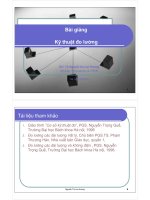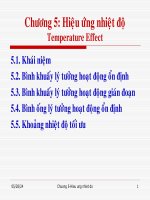BÀI GIẢNG kỹ THUẬT đo LƯỜNG chương 5 các cơ cấu chỉ thị
Bạn đang xem bản rút gọn của tài liệu. Xem và tải ngay bản đầy đủ của tài liệu tại đây (1.45 MB, 44 trang )
BÀI GIẢNG KỸ THUẬT ĐO LƯỜNG - Chương
5: Các cơ cấu chỉ thị
$1 Khái niệm chung
•Cơ cấu chỉ thị dùng để hiển thị kết quả đo
•- Chỉ thị điện cơ: chủ yếu là dụng cụ kim quay, tịnh tiến hoặc băng giấy
•Chỉ thị điện tử: chủ yếu là dao động kí, monitor…
•Chỉ thị điện tử số: LED, đèn catod nguội, LCD, Plasma, SED, OLED…
X
Cơ cấu
cảm biến
cơ-điện
Ux
Chỉ thị
điện-cơ
M
dW
Mq =
dα
M c = Dα
Mq1
Mc
10/23/15
α1α2α3
α
M c = f (α )
Mq = Mc
Vị trí cân bằng, góc
ổn định
1
Một số chi tiết trong cơ cấu điện cơ
10/23/15
2
$2 a. Chỉ thị từ điện
W = ΦI sin α = BswI sin α
dW
= BswI cos α ≈ BswI (α <<)
dα
M c = Dα
Mq =
Mq = Mc ⇒ α =
1
BswI
D
Nhận xét:
-Đo dòng điện DC
-Thang chia độ đều
-Quán tính nhỏ, đo được tín hiệu yếu
-Độ bền cơ học kém
-Dùng đo áp, dòng, điện trở…
B
10/23/15
3
10/23/15
4
b. Logomet từ điện
dW1
dΦ 1
= I1
dα
dα
dW2
dΦ 2
W2 = Φ 2 I 2 ⇒ M 2 =
= I2
dα
dα
dΦ1 / dα I 2
M1 = M 2 ⇔
= = f (α )
dΦ 2 / dα I 1
W1 = Φ1 I1 ⇒ M 1 =
I
α = g 2
I1
-Thang đo đều
- Đo một chiều
- Độ bền cơ học kém
- Đo điện trở, tổng trở…
10/23/15
5
$3 Dụng cụ điện từ
• 1. Chỉ thị điện từ
1 2
dW 1 2 dL
LI ⇒ M q =
= I
2
dα 2 dα
M c = Dα
W=
Mq = Mc
⇒α =
1 2 dL
I
= f (I 2 )
2 D dα
-Dụng cụ dùng đo cả xoay chiều lẫn một chiều
-Thang chia độ không đều
-Độ bền cơ học tốt
-Độ chính xác không cao
-Độ nhạy thấp
10/23/15
6
Logomet điện từ
1
1
L1 I12 ; W2 = L2 I 22
2
2
dW1 1 2 dL1
M1 =
= I1
dα 2 dα
dW2 1 2 dL2
M2 =
= I2
dα
2 dα
M1 = M 2
W1 =
I12
⇒ α = f 2
I2
-Dùng đo cả xoay chiều và một chiều
-Thang đo không đều
-Đo điện trở, điện cảm, điện dung…
10/23/15
7
$4 Cơ cấu điện động
* Với dòng điện một chiều
1
1
L1 I12 + L2 I 22 + M 12 I1 I 2
2
2
dW
dM 12
= M q = I1 I 2
dα
dα
M c = Dα
W=
Mq = Mc ⇒ α =
* Với dòng xoay chiều
1
dM 12
I1 I 2
D
dα
dM 12
I1m sin ωtI 2 m sin ( ωt + ϕ )
dα
T
1 T
1 dM 12
M q = ∫ mq dt =
I1m I 2 m ∫ sin ωt sin ( ωt + ϕ )dt
0
T 0
T dα
dM 12
=
I1m I 2 m cos ϕ = Dα
2dα
1 dM 12 I1m I 2 m
1 dM 12
α=
cos ϕ =
I1 I 2 cos ϕ
D dα
D dα
2 2
mq =
10/23/15
8
Logomet điện động
dM 1I
M 1 = I1 I cos α cos( I , I1 )
dα
dM 2 I
M 2 = I 2 I cos( γ − α ) cos( I , I 2 )
dα
dM 1I dM 2 I
M1 = M 2 ;
=
dα
dα
I1 cos( I , I1 )
α = f
I 2 cos( I , I 2 )
Loại này dùng đo điện áp, dòng điện, công suất…
10/23/15
9
10/23/15
10
Cơ cấu sắt điện động
mq = Bt s2 wwi2
1 T
M q ∫ mq dt = Bs2 w2 I 2 cos( B, I 2 )
T 0
B ≈ kI1
M q = ks2 w2 I1 I 2 cos( I1 , I 2 ) = Dα
α=
10/23/15
1
ks2 w2 I1 I 2 cos( I1 , I 2 )
D
11
$5 Cơ cấu cảm ứng
i1
ϕ
M q = Cf1Φ1Φ 2 sin ϕ
Vậy cơ cấu này có thể đo tần
số, từ thông, công suất, góc
pha, điện năng.
i2
ix1
e1
ix2
e2
10/23/15
12
10/23/15
13
$7 Chỉ thị dao động kí
B1
10/23/15
B2
14
10/23/15
15
10/23/15
16
Điều khiển quét trên màn hình
10/23/15
17
Cutaway rendering of a color CRT: 1. Electron guns 2. Electron beams
3. Focusing coils 4. Deflection coils 5. Anode connection 6. Mask for
separating beams for red, green, and blue part of displayed image
7. Phosphor layer with red, green, and blue zones 8. Close-up of the
phosphor-coated inner side of the screen
10/23/15
18
10/23/15
Close-up of a color CRT.
19
Oscilloscope tubes
For use in an oscilloscope, the design is somewhat different. Rather than
tracing out a raster, the electron beam is directly steered along an arbitrary
path, while its intensity is kept constant. Usually the beam is deflected
horizontally (X) by a varying potential difference between a pair of plates to its
left and right, and vertically (Y) by plates above and below, although magnetic
deflection is possible. The instantaneous position of the beam will depend
upon the X and Y voltages. It is most useful for the horizontal voltage,
repeatedly, to increase linearly with time until the beam reaches the edge of
the screen, then jump back to its starting value (sawtooth waveform,
generated by a timebase). This causes the display to trace out the Y voltage
as a function of time. Many oscilloscopes only function in this mode. However
it can be useful to display, say, the voltage versus the current in an inductive
component with an oscilloscope that allows X-Y input, without using the
timebase.
10/23/15
20
Computer displays
Shadow mask close-up
10/23/15
21
Spectra of constituent blue, green and red phosphors in a common CRT
10/23/15
22
Màn hình Plasma
10/23/15
23
• What is Plasma?
The central element in a fluorescent light is a plasma, a gas made up of freeflowing ions (electrically charged atoms) and electrons (negatively charged
particles). Under normal conditions, a gas is mainly made up of uncharged
particles. That is, the individual gas atoms include equal numbers of protons
(positively charged particles in the atom's nucleus) and electrons. The negatively
charged electrons perfectly balance the positively charged protons, so the atom
has a net charge of zero.
10/23/15
24
• If you introduce many free electrons into the gas by establishing an
electrical voltage across it, the situation changes very quickly. The
free electrons collide with the atoms, knocking loose other electrons.
With a missing electron, an atom loses its balance. It has a net
positive charge, making it an ion.
• In a plasma with an electrical current running through it, negatively
charged particles are rushing toward the positively charged area of
the plasma, and positively charged particles are rushing toward the
negatively charged area.
10/23/15
25









